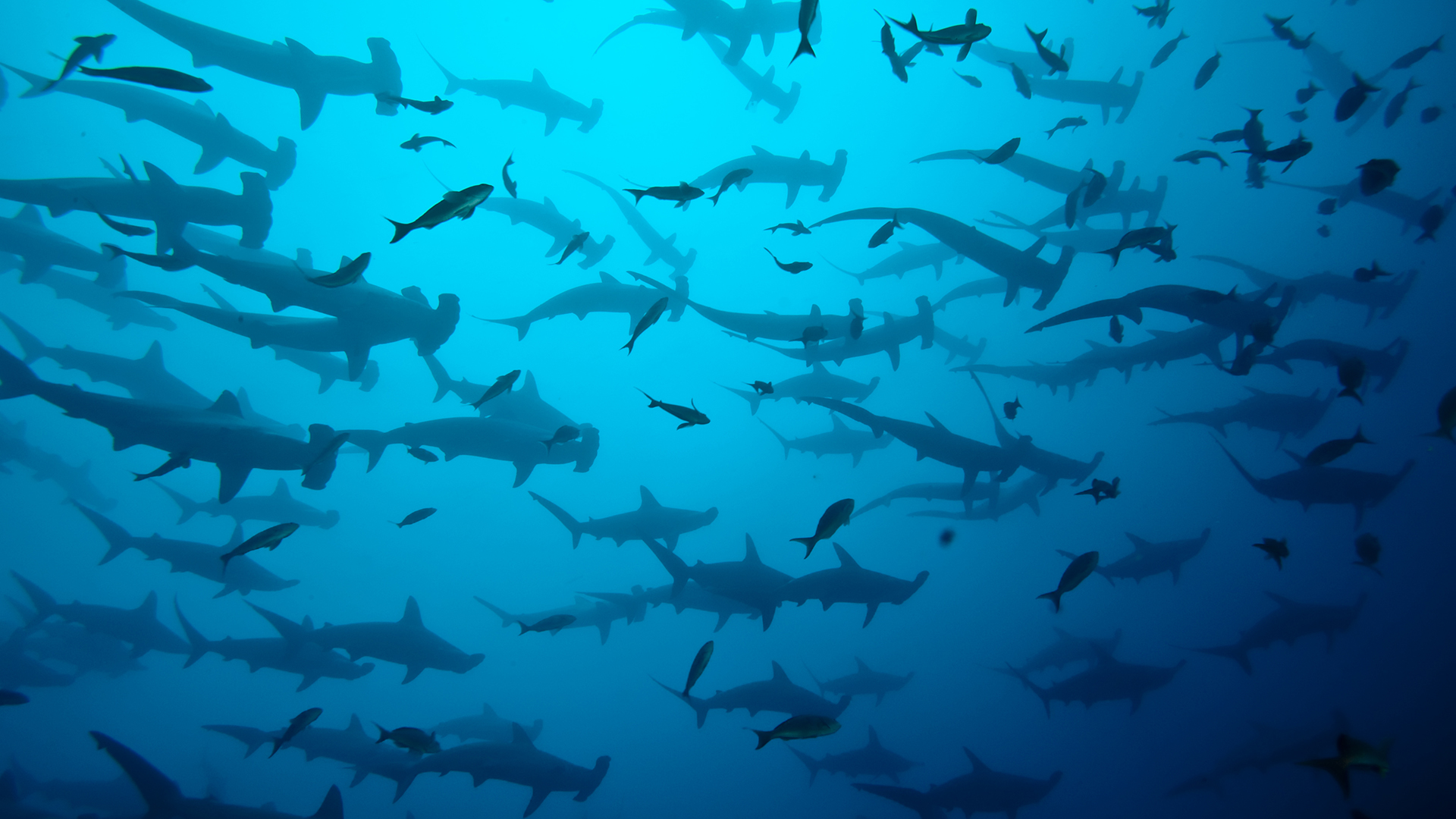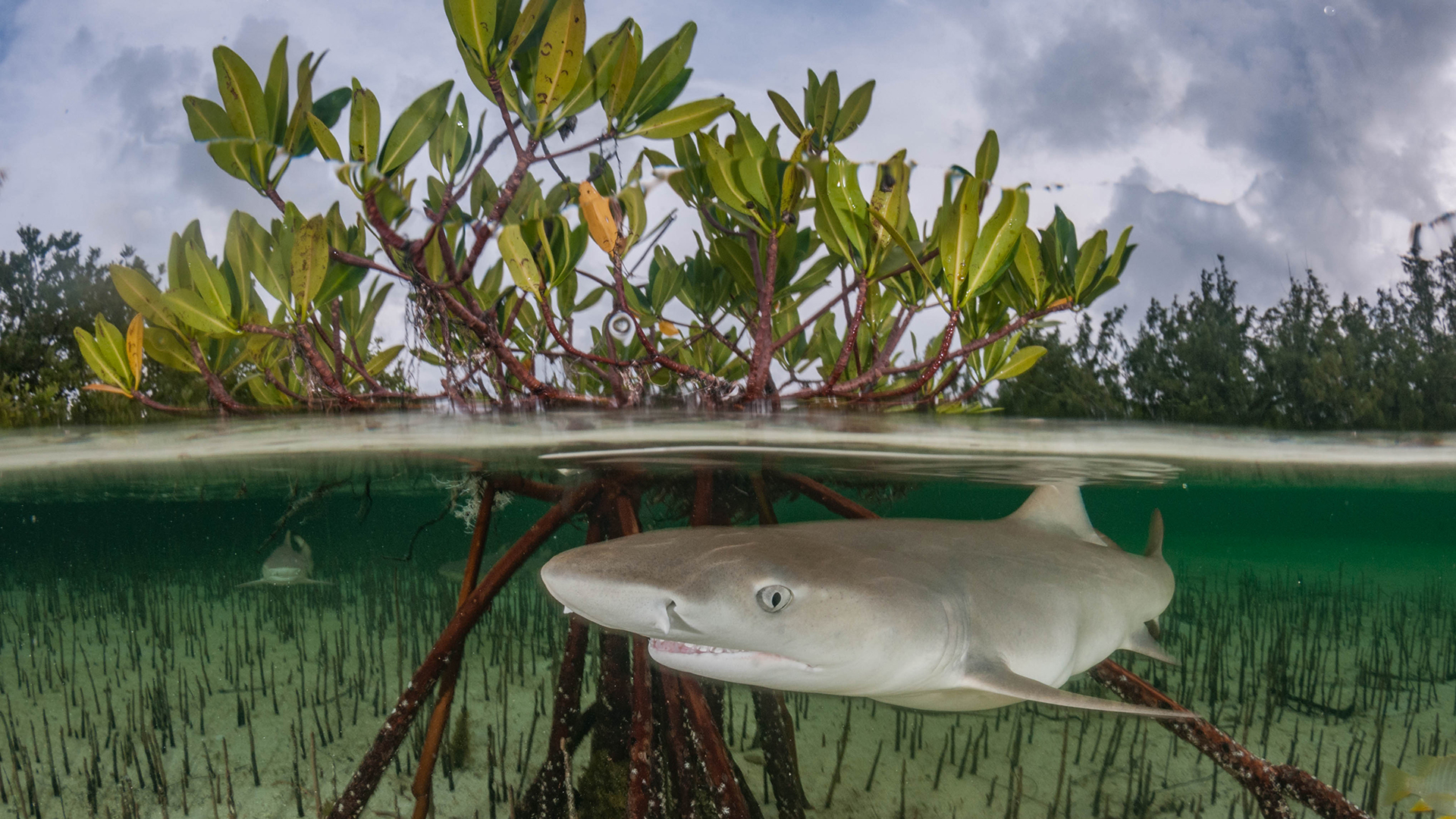
What If There Were No Sharks?
What would the oceans look like if all of the sharks disappeared?

Sharks are magnificent predators that represent an impressive evolutionary success story. They've swum the oceans for more than 400 million years, diversifying over time to inhabit rivers and lakes as well. About 500 known species are alive today, and there are likely even more yet to be discovered.
Sharks can be huge, like the massive whale shark (Rhincodon typus); or human-hand-size, like the pocket shark (Mollisquama parini). However, it's the great white shark (Carcharodon carcharias) that typically commands the public's imagination. These sharks have a reputation for aggressiveness toward people, shaped by decades of terrifying portrayals in movies. In fact, these fearful pop-culture portraits of great whites are so pervasive that they might lead some people to wonder if the world would be better off with no sharks at all.
But what might the oceans look like if all of the sharks disappeared?
Related: 7 Unanswered Questions About Sharks
Sharks make their homes in ecosystems around the world, including shallow mangrove habitats, tropical coral reefs, frigid Arctic waters and the vastness of the open ocean. Regardless of where sharks live or how big they are, all of them are predators and, therefore, are vitally important to the health of their habitats, said Jenny Bortoluzzi, a doctoral candidate in the Department of Zoology at Trinity College Dublin in Ireland.
Fish-hunting sharks weed out weak and sick individuals, ensuring that the fish population remains healthy and at a size that the habitat's resources can support. These fearsome predators can even help to preserve their ecosystems through their presence alone, Bortoluzzi told Live Science in an email. For example, tiger sharks (Galeocerdo cuvier) that live in seagrass meadows scare away turtles and keep them from overgrazing the vegetation, she explained.
Sharks also play a role in regulating oxygen production in the ocean, by feeding on fish that devour oxygen-generating plankton, Victoria Vásquez, a doctoral candidate with Moss Landing Marine Laboratories in California, told Live Science in an email.
Sign up for the Live Science daily newsletter now
Get the world’s most fascinating discoveries delivered straight to your inbox.

Coral reef environments are another good example of sharks' importance for overall biodiversity and ecosystem health, said Toby Daly-Engel, an assistant professor in the marine science department and director of the Shark Conservation Lab at Florida Tech.
"If the sharks disappear, the little fish explode in population, because nothing's eating them," Daly-Engel told Live Science. "Pretty soon, their food — plankton, microorganisms, little shrimps — all of that is gone, so all the little fish ultimately starve."
When that happens, algae and bacteria move into the reef, covering the coral so that it can't photosynthesize. "The coral will die, leaving just its skeleton behind, which eventually turns into limestone," Daly-Engel said. "Then, in come the animals like starfishes and sea urchins; we call those grazers. So instead of a bunch of different species — sharks, bony fishes, invertebrates and mollusks — you end up with a reef with four to five species in it, tops. That's a dead reef."
Sharks serve another important role in ocean food webs: They are food for marine carnivores. Dead great white sharks that washed up on South African beaches without their livers were thought to have been victims of orca attacks. And video footage recently showed a dogfish shark (Squalus clarkae) feeding frenzy on the bottom of the Atlantic that ended with a grouper swallowing one of the sharks whole. Even octopuses are known to feed on sharks, as demonstrated in a video that National Geographic posted to YouTube in 2009.
Migrating sharks, such as the gray reef shark (Carcharhinus amblyrhynchos), also provide nourishment for organisms in multiple locations in the ocean, by leaving behind generous helpings of their nitrogen-rich poo, marine biologist Melissa Cristina Márquez wrote in Forbes earlier this year. Márquez is the founder of The Fins United Initiative, which provides educational resources about sharks and their close relatives skates and rays.
In fact, gray reef shark forays between coastal waters and the deep sea in the Pacific Ocean's Palmyra Atoll bring the reef more than 200 lbs. (95 kilograms) of nutritious nitrogen per day, Márquez wrote.
A murky future
Approximately 25% of all shark, skate and ray species are currently threatened with extinction, according to the Smithsonian Institution's Ocean Portal. Because sharks have few babies and are slow to mature, their numbers aren't replenishing quickly enough to keep up with losses from commercial fishing, Daly-Engel said.
In recent decades, some shark populations have declined by up to 90%, reflecting an unsustainable trend of overexploitation in ocean habitats, according to Bortoluzzi.
"Many species also face the loss of habitats, with refuge areas such as mangroves being destroyed to accommodate our growing human population, and habitats such as seabeds and reefs being damaged by destructive fishing methods such as trawling," Bortolozzi said.
Related: On the Brink: A Gallery of Wild Sharks
What does the future hold for sharks? Federal legislation and international treaties such as the Convention on International Trade in Endangered Species of Wild Fauna and Flora can help to protect vulnerable populations. But many shark species are poorly understood, which can hinder conservation efforts, said Michael Scholl, CEO of the nonprofit Save Our Seas Foundation.
"Government institutions must have validated information to support significant decline in populations, for example," Scholl told Live Science in an email. To that end, Save Our Seas works alongside marine researchers to gather shark data that can inform much-needed protective measures; the nonprofit also works to raise public awareness of shark diversity and its importance to their marine ecosystems, Scholl said.
But sharks may be running out of time. And if they were to disappear, the repercussions on ocean food webs would ultimately affect humans, too.
"Fisheries may collapse, with artisanal fishers being the likely most affected, and popular tourism destinations which rely on sharks to attract tourists will also suffer greatly," Bortoluzzi said.
"It's important to understand that as much as our oceans need sharks, so do we," she added.
Editor's note: The article was updated on Sept. 9 to correct the species of dogfish shark that was swallowed by a grouper in a YouTube video: Squalus clarkae, not Squalus acanthias.

Mindy Weisberger is an editor at Scholastic and a former Live Science channel editor and senior writer. She has reported on general science, covering climate change, paleontology, biology and space. Mindy studied film at Columbia University; prior to Live Science she produced, wrote and directed media for the American Museum of Natural History in New York City. Her videos about dinosaurs, astrophysics, biodiversity and evolution appear in museums and science centers worldwide, earning awards such as the CINE Golden Eagle and the Communicator Award of Excellence. Her writing has also appeared in Scientific American, The Washington Post and How It Works Magazine. Her book "Rise of the Zombie Bugs: The Surprising Science of Parasitic Mind Control" will be published in spring 2025 by Johns Hopkins University Press.









